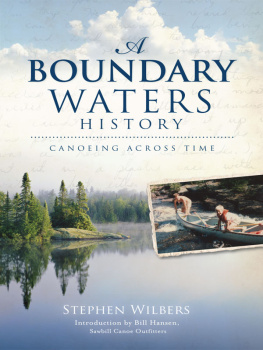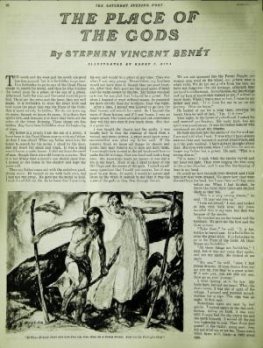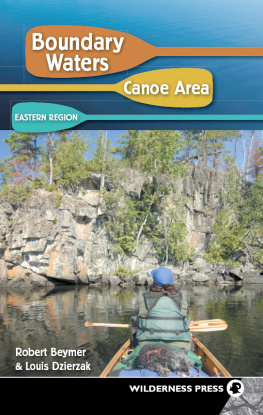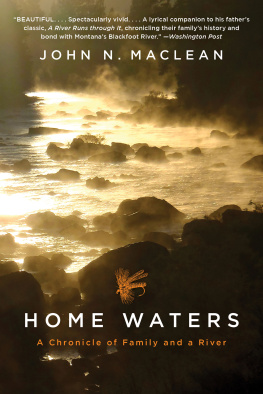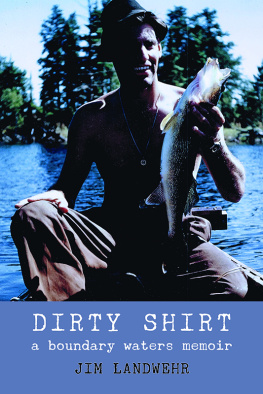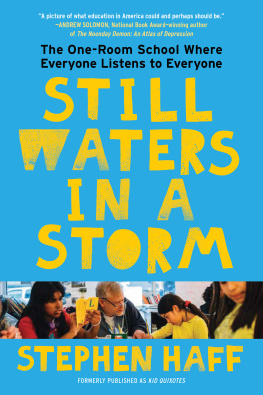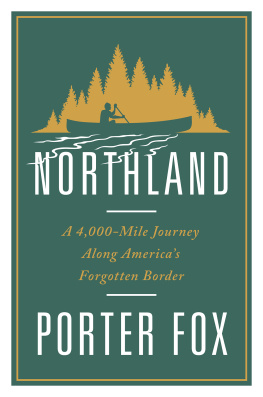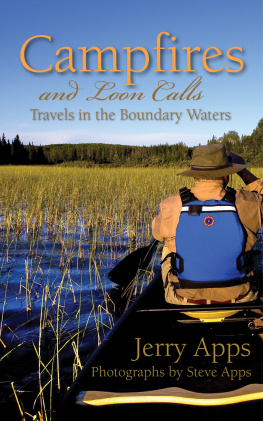

Published by The History Press
Charleston, SC 29403
www.historypress.net
Copyright 2011 by Stephen Wilbers
All rights reserved
Cover image used with permission of Craig Blacklock of Blacklock Photography Galleries.
www.blacklockgallery.com
First published 2011
e-book edition 2013
Manufactured in the United States
ISBN 978.1.62584.189.6
Library of Congress Cataloging-in-Publication Data
Wilbers, Stephen, 1949
A Boundary Waters history : canoeing across time / Stephen Wilbers.
p. cm.
Includes bibliographical references and index.
print edition ISBN 978-1-59629-970-2
1. Boundary Waters Canoe Area (Minn.)--History. 2. Boundary Waters Canoe Area (Minn.)--Description and travel. 3. Wilbers, Stephen, 1949---Travel--Minnesota--Boundary Waters Canoe Area. 4. Canoes and canoeing--Minnesota--Boundary Waters Canoe Area. 5. Natural history--Minnesota--Boundary Waters Canoe Area. 6. Boundary Waters Canoe Area (Minn.)--Environmental conditions. I. Title.
F612.B73W55 2011
977.675--dc23
2011021479
Notice: The information in this book is true and complete to the best of our knowledge. It is offered without guarantee on the part of the author or The History Press. The author and The History Press disclaim all liability in connection with the use of this book.
All rights reserved. No part of this book may be reproduced or transmitted in any form whatsoever without prior written permission from the publisher except in the case of brief quotations embodied in critical articles and reviews.
To my dad, Larry Wilbers
With special thanks to Joe Paddock, who never lost faith in my ability to write this book
Enjoy your trip on thewhat are the Boundary Waters? Is it that dotted line across Lake Superior?
A newspaper editor in Texas wishing the author a good trip
CONTENTS
FOREWORD
This is a love story.
Built on a framework of personal journals, this book is a record of nearly thirty years of canoe trips, taken almost entirely in the Boundary Waters Canoe Area (BWCA) Wilderness in northeastern Minnesota. Naturally, as the years flow by, Steves appreciation of the wilderness grows, along with his skills as a wilderness canoeist. His observations become more detailed, more fish are caught and scenery and wildlife sightings are less about the thrill of encounter and more about the complexity of relationships that swirl in the wild landscape. The paddling, portaging and camp craft become polished routines that offer the deep satisfaction of a job well done.
If this memoir were only a description of Steves wilderness experiences or an account of the history of the Boundary Waters Canoe Area Wilderness, it would be a satisfying and rewarding read. But its much more. Within these three decades of canoe trips, Steve explores and reveals his relationships with his father, brothers and friendsbut especially with his father. In the juxtaposition of these two stories, a deeper meaning is revealed. The high moments (a paddle across a moonlit lake, the sound of wolves howling, approval in a fathers voice) and the low moments (an overturned canoe pinned in rapids, a swarm of tormenting mosquitoes, a painful divorce) become a metaphor for all of life. Rarely do good things come without great effort. Pain and conflict are the context for happiness, and finally, at the end of the trail, love and companionship are the memories that are treasured.
Although Ive canoed the wilderness with Steve only once, his wilderness experience has informed our relationship. For more than fifty years, Ive spent the canoeing season talking to people who are either beginning or ending a wilderness canoe trip here at Sawbill Canoe Outfitters on the southern edge of the BWCA Wilderness. Ive always felt that the people who enjoy wilderness are an unusually agreeable and interesting group. For starters, everyone looks the same. They all wear sturdy, practical clothing and talk about scenery, wildlife, weather and fishing. Most, if not all, of the normal social cues to class and culture are missing, so people meet one another as simply human, with most cultural preconceptions stripped away. Out of the thousands of people Ive met in the context of our familys business, a few have become treasured friends. This chemistry is somewhat mysterious, but as the years go by, I realize that it is, more often than not, recognition of a kindred spirit in a deep and abiding love of wild places. Steve, his father, Larry, and I connected on that level many years ago, and that connection has sustained a wonderful friendship. Even though we see each other only briefly each year, this attenuation along the same wavelength has created a strong and lasting bond.
The greatest joy of this book for me is how it leads my mind to the magic wilderness memories I share with my family. I was very lucky to be born to parents who decided (Im still not entirely sure why) in 1957 to start a canoe outfitting business on the edge of what would become the BWCA Wilderness. Although I enjoyed many wilderness canoe trips with my parents, my best memories of them revolve around the business. They were successful, but unusual, businesspeople in their commitment to putting people before profit. They were physically and emotionally generous, with both customers and crew, and always mindful of the real benefits of wilderness canoeingpeace, solitude, renewal and a new perspective on modern life. Like Steves family, and all families, the way was not always smooth, but it is the rough water that makes the smooth water so sweet.
Unlike Steve, I rarely kept journals of my trips with my family or even took many pictures, for that matter. I always preferred to let the memories be the record of our trips, and I have many that are precious. While reading this book, I remembered lying in the bottom of the canoe with my son Adam on Cherokee Lake when he was five (and up well past his bedtime) watching the stars, satellites and meteors. I remembered my daughter Ruthie swelling with four-year-old pride and confidence when she overheard a group of women we met on a portage comment that the pack she was carrying was larger than the packs they were carrying. I remembered my daughter Clare carefully stowing her paddle near the end of a long day of travel in torrential rain and explaining that she was not paddling anymore because she wasnt ready for the trip to end. I remembered being huddled under a tarp with my son Carl at the base of a huge waterfall in a very remote Canadian wilderness as lightning raged around us and rain fell so hard that we couldnt see our tent ten feet awayand the huge relief we shared when the storm left us unharmed. I remembered listening to a howling pack of wolves chase a moose into the water less than fifty yards from the tent where my wife, Cindy, and I cuddled closer with each other and with our normally outgoing retriever, who was suddenly very meek.
If you have memories like these, they will be evoked as you read this book. But more importantly, you will be inspired to create new memories and to establish traditions that lead to deeper appreciation for this fragile planet and the people you love. So cinch up the pack straps, slide the canoe into the water, gather the paddles and life vests and embark on this journey of love.
Bill Hansen
Sawbill Canoe Outfitters
Sawbill Lake
March 2011
PREFACE
Located on the northern border of Minnesota within the 14,500-square-mile Rainy Lake watershed, the Boundary Waters Canoe Area Wilderness comprises more than one million acres of protected forests, lakes and streams. To the east lies Lake Superior, to the west Voyageurs National Park and to the north Canadas Quetico Provincial Park. When you launch your canoe in Sawbill Lake, as canoe outfitter Bill Hansen says on the back of his old map, It is exciting to know that you could keep paddling north through unbroken wilderness all the way to Hudson Bay.
Next page
